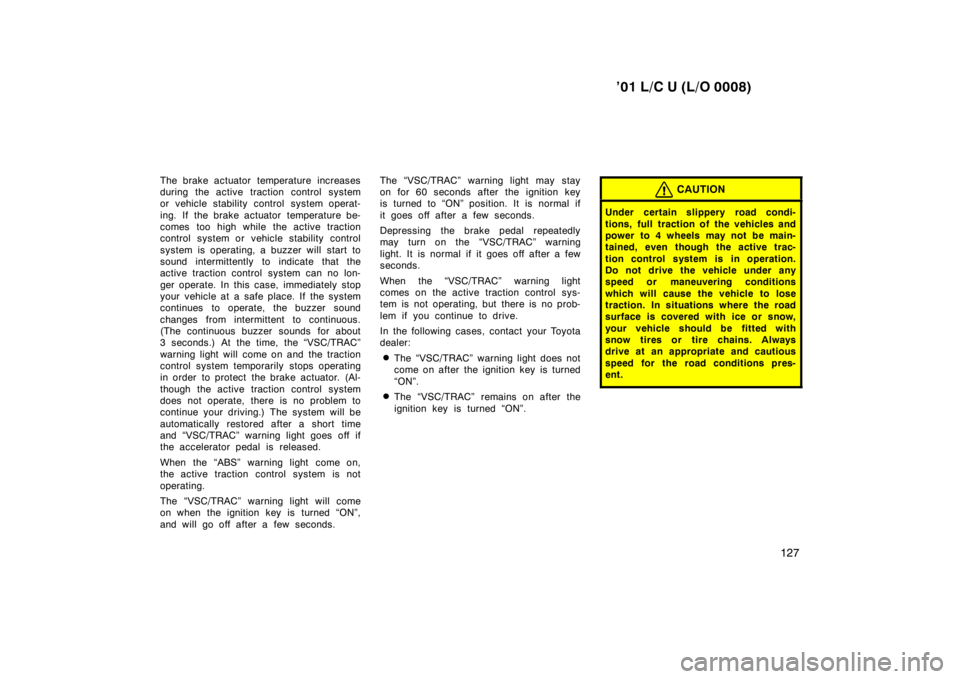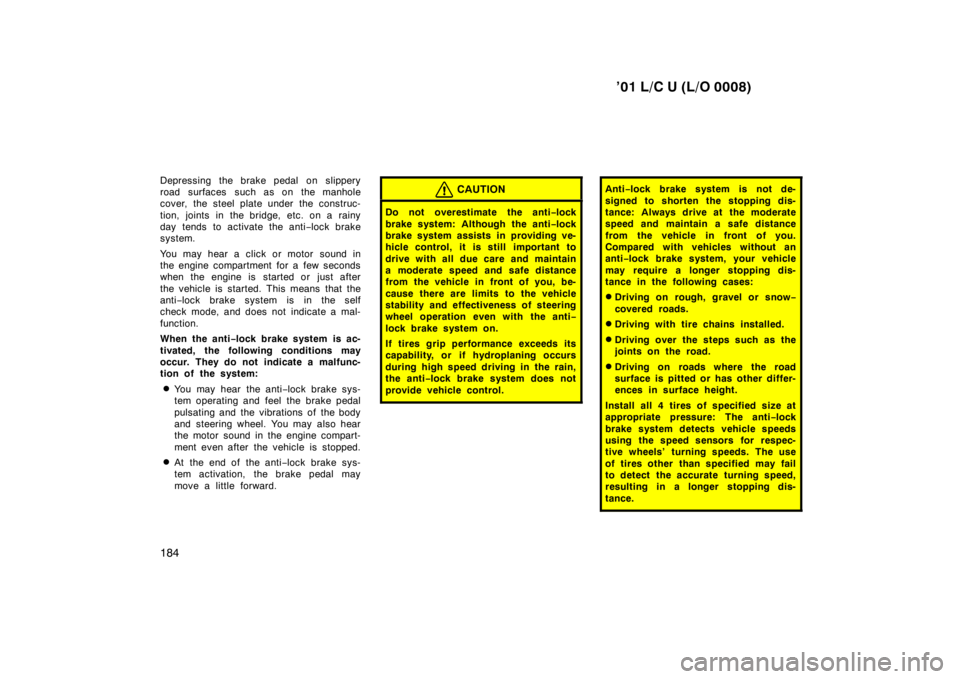snow chains TOYOTA LAND CRUISER 2001 Owners Manual
[x] Cancel search | Manufacturer: TOYOTA, Model Year: 2001, Model line: LAND CRUISER, Model: TOYOTA LAND CRUISER 2001Pages: 142, PDF Size: 2.96 MB
Page 47 of 142

’01 L/C U (L/O 0008)127
The brake actuator temperature increases
during the active traction control system
or vehicle stability control system operat-
ing. If the brake actuator temperature be-
comes too high while the active traction
control system or vehicle stability control
system is operating, a buzzer will start to
sound intermittently to indicate that the
active traction control system can no lon-
ger operate. In this case, immediately stop
your vehicle at a safe place. If the system
continues to operate, the buzzer sound
changes from intermittent to continuous.
(The continuous buzzer sounds for about
3 seconds.) At the time, the “VSC/TRAC”
warning light will come on and the traction
control system temporarily stops operating
in order to protect the brake actuator. (Al-
though the active traction control system
does not operate, there is no problem to
continue your driving.) The system will be
automatically restored after a short time
and “VSC/TRAC” warning light goes off if
the accelerator pedal is released.
When the “ABS” warning light come on,
the active traction control system is not
operating.
The “VSC/TRAC” warning light will come
on when the ignition key is turned “ON”,
and will go off after a few seconds.
The “VSC/TRAC” warning light may stay
on for 60 seconds after the ignition key
is turned to “ON” position. It is normal if
it goes off after a few seconds.
Depressing the brake pedal repeatedly
may turn on the “VSC/TRAC” warning
light. It is normal if it goes off after a few
seconds.
When the “VSC/TRAC” warning light
comes on the active traction control sys-
tem is not operating, but there is no prob-
lem if you continue to drive.
In the following cases, contact your Toyota
dealer:
� The “VSC/TRAC” warning light does not
come on after the ignition key is turned
“ON”.
� The “VSC/TRAC” remains on after the
ignition key is turned “ON”.
CAUTION
Under certain slippery road condi-
tions, full traction of the vehicles and
power to 4 wheels may not be main-
tained, even though the active trac-
tion control system is in operation.
Do not drive the vehicle under any
speed or maneuvering conditions
which will cause the vehicle to lose
traction. In situations where the road
surface is covered with ice or snow,
your vehicle should be fitted with
snow tires or tire chains. Always
drive at an appropriate and cautious
speed for the road conditions pres-
ent.
Page 92 of 142

’01 L/C U (L/O 0008)
184
Depressing the brake pedal on slippery
road surfaces such as on the manhole
cover, the steel plate under the construc-
tion, joints in the bridge, etc. on a rainy
day tends to activate the anti
−lock brake
system.
You may hear a click or motor sound in
the engine compartment for a few seconds
when the engine is started or just after
the vehicle is started. This means that the
anti −lock brake system is in the self
check mode, and does not indicate a mal-
function.
When the anti −lock brake system is ac-
tivated, the following conditions may
occur. They do not indicate a malfunc-
tion of the system:
� You may hear the anti −lock brake sys-
tem operating and feel the brake pedal
pulsating and the vibrations of the body
and steering wheel. You may also hear
the motor sound in the engine compart-
ment even after the vehicle is stopped.
� At the end of the anti −lock brake sys-
tem activation, the brake pedal may
move a little forward.
CAUTION
Do not overestimate the anti −lock
brake system: Although the anti −lock
brake system assists in providing ve-
hicle control, it is still important to
drive with all due care and maintain
a moderate speed and safe distance
from the vehicle in front of you, be-
cause there are limits to the vehicle
stability and effectiveness of steering
wheel operation even with the anti −
lock brake system on.
If tires grip performance exceeds its
capability, or if hydroplaning occurs
during high speed driving in the rain,
the anti −lock brake system does not
provide vehicle control.
Anti −lock brake system is not de-
signed to shorten the stopping dis-
tance: Always drive at the moderate
speed and maintain a safe distance
from the vehicle in front of you.
Compared with vehicles without an
anti −lock brake system, your vehicle
may require a longer stopping dis-
tance in the following cases: � Driving on rough, gravel or snow −
covered roads.
� Driving with tire chains installed.
� Driving over the steps such as the
joints on the road.
� Driving on roads where the road
surface is pitted or has other differ-
ences in surface height.
Install all 4 tires of specified size at
appropriate pressure: The anti −lock
brake system detects vehicle speeds
using the speed sensors for respec-
tive wheels’ turning speeds. The use
of tires other than specified may fail
to detect the accurate turning speed,
resulting in a longer stopping dis-
tance.